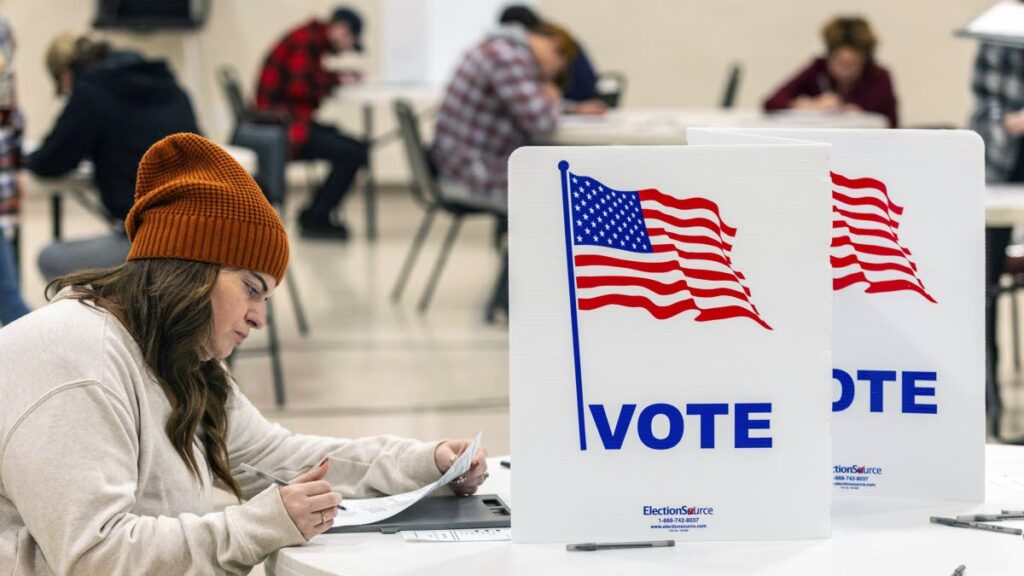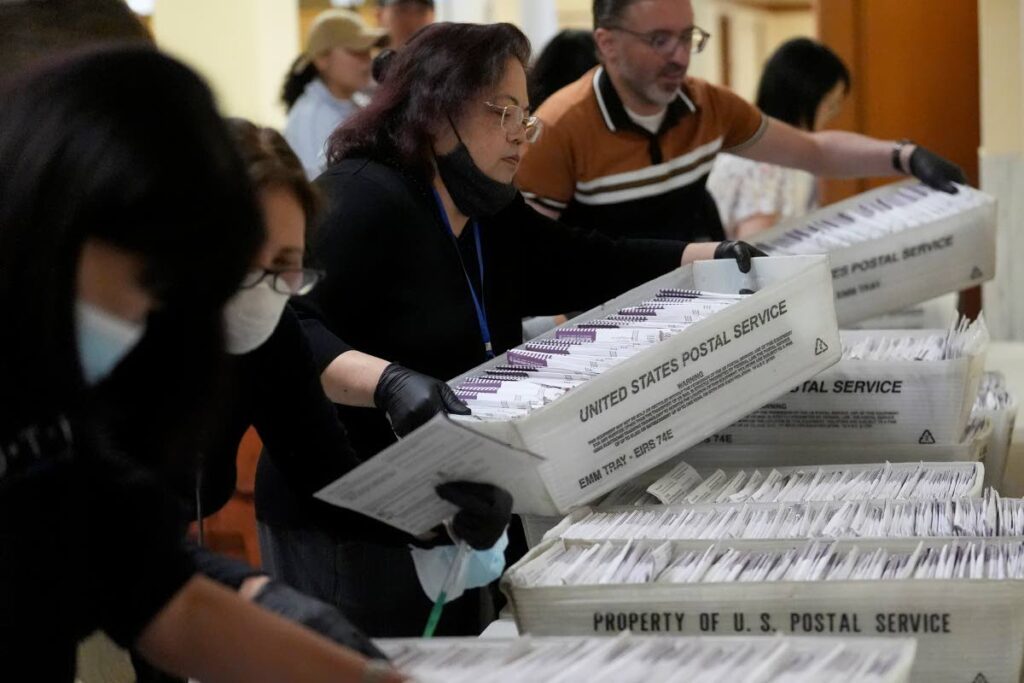This is how US presidential elections work

ON November 5, Americans went to the polls to elect their 47th president.
Their choice was between Vice President Kamala Harris and former president Donald Trump – the Democratic and Republican candidates respectively.
So far, over 80 million Americans have already voted.
There are seven battleground states which are key to either the Democrats or the Republicans winning the election.
They are Georgia, North Carolina, Pennsylvania, Michigan, Wisconsin, Nevada and Arizona.
Regarded as being similar to marginal constituencies, the votes in these states are not guaranteed for either the Democrats or Republicans compared to other states.
In the final week of the campaign, Harris and Trump barnstormed these states, making their final pitches to crucial voters that could put them in the White House.
A USA Today report on November 4 said a Des Moines Register/Mediacom Iowa Poll on November 2 showed Harris ahead of Trump in Iowa by three points, though the result is within the survey's margin of error.
The state had been considered a safe state for Trump ahead of the election.
An Al-Jazeera report on November 5 about early voting said Harris and Trump are in a head-to-head race that remains too close to call.
A UK Guardian report said it is unlikely that either Harris or Trump could be declared the winner on November 5 because they are "virtually tied in the polls, and the odds that the race comes down to a small number of swing states is high."
US presidential elections are different from elections held in other countries.
Candidates must first secure party's nomination
The election takes place every four years on the first Tuesday in November.
Candidates must be at least 35, born in the US and must have lived there for the previous 14 years in order to be eligible as candidates.
Traditionally, candidates make their intention to run for president public in the year before the election takes place.
Since there is no national authority which conducts the elections, local authorities organise the election with the help of thousands of administrators.
The election process starts with the primaries and caucuses in January or February of the election year.
Primaries are organised by state and local authorities using a secret ballot to cast votes for hopeful presidential candidates from each of the major parties.
Caucuses are private events organised by political parties themselves. Here, voters decide publicly which candidate they prefer. Afterwards, organisers count the votes and calculate how many delegates each candidate receives.
Each state, the District of Columbia and some US territories are allocated a number of delegates, usually determined by population size.
In addition, a formula is used to adjust the number by “rewarding” states which, for example, voted for the last party’s presidential candidate. These delegates represent their state in the national party convention and vote to decide each party’s presidential candidate.
There a two main types of delegates:
- Pledged delegates – who have to support the candidate to whom they were assigned in a primary or caucus.
- Unpledged or superdelegates – who can choose freely which candidate they would like to support.
The national conventions of each party are held in the summer of an election year.
A majority of delegates’ votes is needed to receive the nomination of the party, which is often already reached and known before the national conventions take place.
If no majority is reached, the national convention is where the presidential candidate will be selected.
After the nominee for each political party have been chosen, the presidential candidates go head-to-head campaigning throughout the country.
They go on rallies and take part in debates to win the support of voters across the nation.
They explain their plans and views to society.
Winner decided by Electoral College, not popular vote
On election day, voters go to the polling place and cast their vote for their preferred candidate.
These votes go to a state-wide tally, with the winning candidate winning all that state's electoral votes.
In most cases, a projected winner is announced on election night after voting has ended.
Unlike many other countries, where the president or prime minister is chosen by direct popular vote, in the US a candidate may win the popular vote and still not be elected president.
The actual result of the election is determined when the Electoral College vote takes place in mid-December, when the electors, whose votes were won by the respective candidates on election night, meet in their states to vote for a winner.
A candidate needs the vote of at least 270 electors in the college – more than half of all electors – to win the election.
The meeting of the college is scheduled for December 17.
States are allocated electors according to the number of seats they have in the House of Representatives and Senate.
Washington, DC, gets three electors, but other US territories don’t get any. In total there are 538 electors (435 House seats plus 100 Senate seats plus three for Washington, DC).
After ballots have been cast, all votes go to a statewide tally. Washington, DC, and 48 states use the first-past-the-post procedure, where the election winner receives all the electors in that state.
In Maine and Nebraska, the rules are slightly different. They have a proportional-representation system in which the winner of each congressional district is awarded one electoral vote, and the winner of the statewide vote is awarded each state's remaining two electoral votes.
There is no constitutional provision or federal law that requires electors to vote for the candidate to whom they are pledged.
Once the college completes its work, the Congress meets on January 6 to count the electoral votes and certify the winner of the election.
Since the incumbent vice president also serves as the president of the Senate, Harris will preside over this exercise next year.
In January 2021, then vice president Mike Pence presided over the vote count when Biden won the 2020 election.
It was on January 6 that year that a mob stormed the US Capitol to prevent the count from being completed.
The attack was ultimately unsuccessful in preventing the certification of the election results for incumbent president Joe Biden and Harris.
President sworn in on January 20
Inauguration Day takes place on January 20 at the US Capitol building in Washington, DC.
First, the vice president is sworn in, followed by the president.
Both officially become president and vice president after reciting the oath of office which has been used since the late 18th century.
In many countries a newly elected leader takes power within a couple weeks or – as in the case of the UK – even the day following an election.
In US politics, this is the period between presidential and congressional elections in November and the inauguration of officials early the next year. More than 11 weeks can pass between election and inauguration days in order to give an incoming president time to choose a cabinet and plan for a new administration.
The result is a lengthy lame-duck period.
This period used to be longer than 11 weeks. The Congress of the Confederation set March 4, 1789, as the date “for commencing proceedings” of the new government established by the US Constitution.
While a particularly bad winter delayed the inauguration of George Washington by eight weeks, subsequent incoming presidents and vice presidents took their oaths of office on March 4.
The four-month gap was needed in part because of the time it took to count and report votes and to travel to the nation’s capital.
However, the lengthy lame-duck period caused problems such as in the aftermath of the 1860 election, when seven states left the Union during the long “Secession Winter.”
President-elect Abraham Lincoln had no power to act, and outgoing president James Buchanan took no action, leaving the issue for his successor.
As technological advances greatly reduced the times to tabulate votes, report the results and travel, such a long lame-duck period was no longer logistically necessary.
As a result, the 20th Amendment, which was ratified on January 23, 1933, moved up Inauguration Day to January 20 and the first meeting of the new Congress to January 3.
The 20th Amendment did not take effect until October 1933, after the long lame-duck period once again proved problematic.
With the US in the throes of the Great Depression, incoming president Franklin D Roosevelt had to wait four months to implement his New Deal while uncertainty further roiled financial markets.
January 20 first served as Inauguration Day in 1937, when Roosevelt was sworn in for a second term.


Comments
"This is how US presidential elections work"